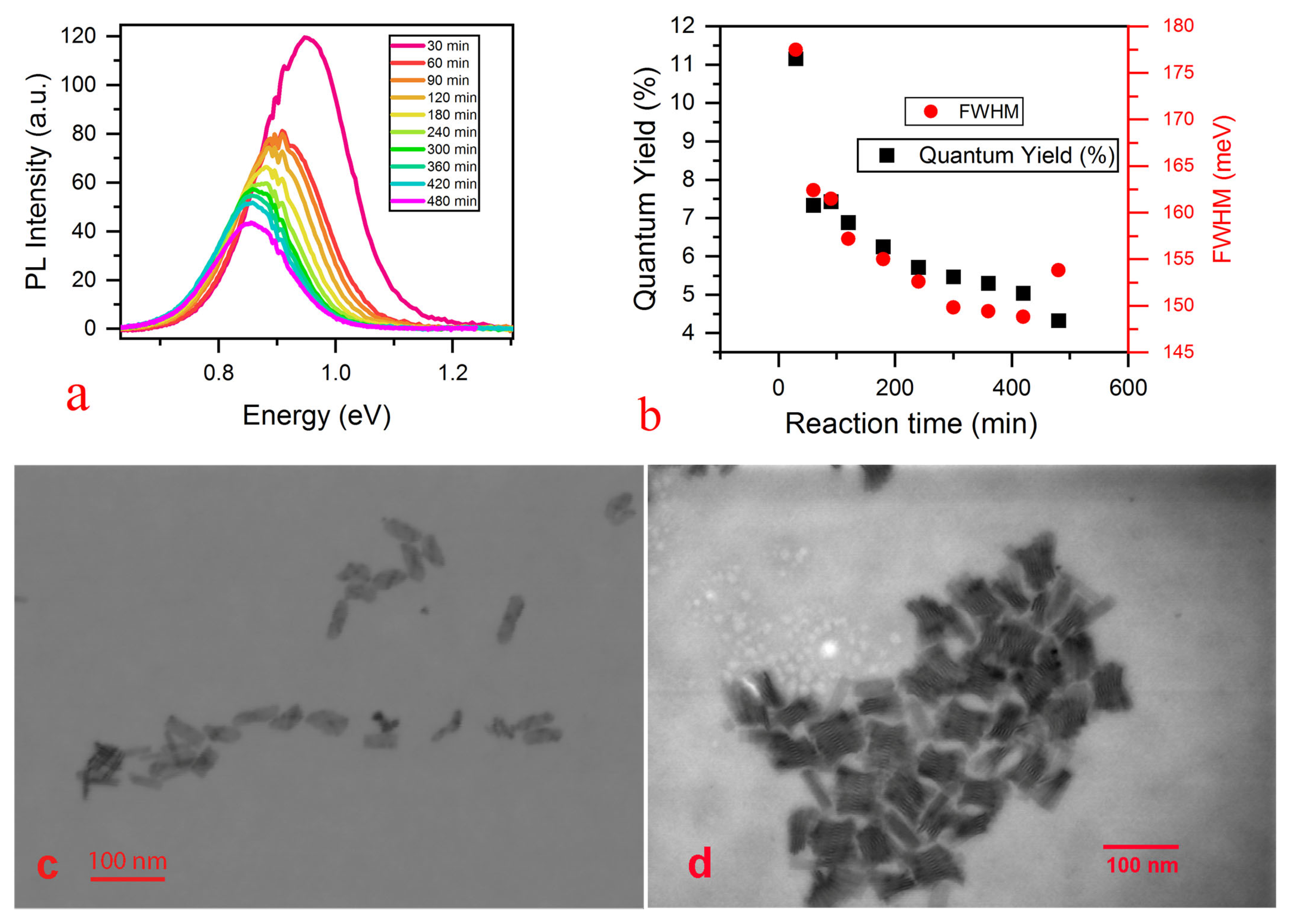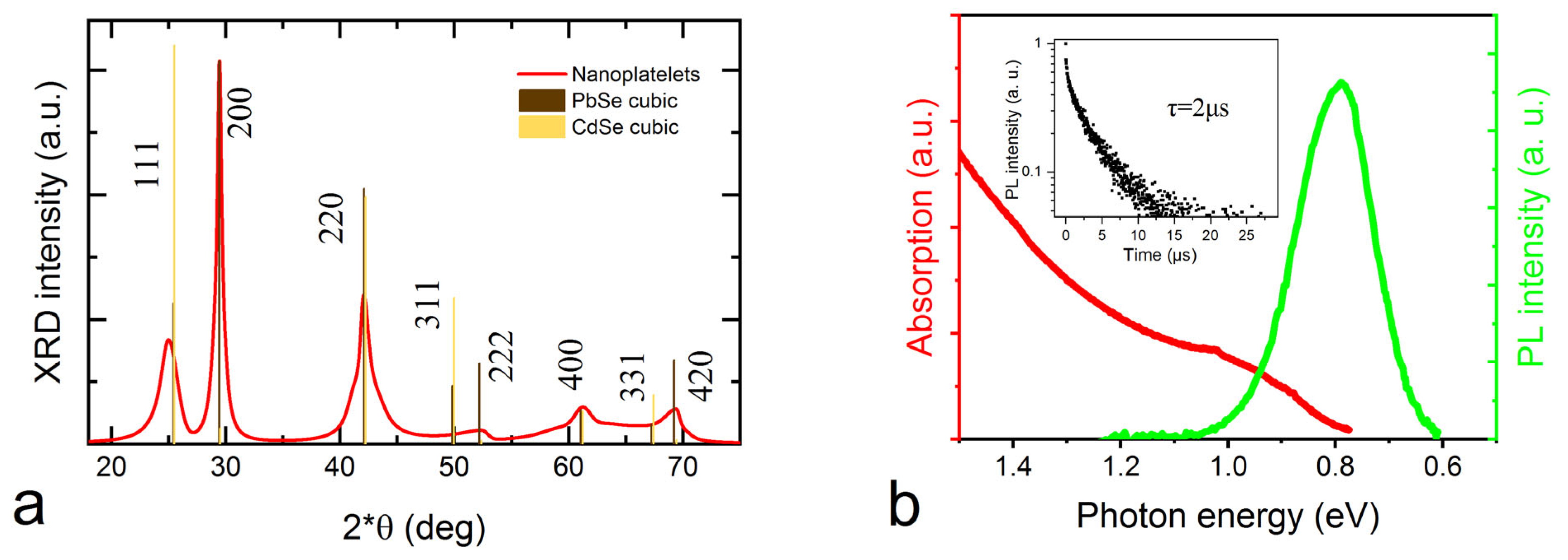PbSe/PbS Core/Shell Nanoplatelets with Enhanced Stability and Photoelectric Properties
Abstract
:1. Introduction
2. Materials and Methods
2.1. Chemicals
2.2. Synthesis of CdSe NPLs
2.3. CdS Shell Growth on the CdSe NPLs
2.4. Cation Exchange
2.5. Methods
3. Results and Discussion
3.1. The Optical Properties Evolution during Synthesis
3.2. Photoresponsivity Measurement
4. Conclusions
Supplementary Materials
Author Contributions
Funding
Data Availability Statement
Acknowledgments
Conflicts of Interest
References
- García de Arquer, F.P.; Talapin, D.V.; Klimov, V.I.; Arakawa, Y.; Bayer, M.; Sargent, E.H. Semiconductor Quantum Dots: Technological Progress and Future Challenges. Science 2021, 373, eaaz8541. [Google Scholar] [CrossRef] [PubMed]
- Press Release: The Nobel Prize in Chemistry 2023. Available online: https://www.nobelprize.org/prizes/chemistry/2023/press-release/ (accessed on 27 October 2023).
- Zhao, P.; Xu, Q.; Tao, J.; Jin, Z.; Pan, Y.; Yu, C.; Yu, Z. Near Infrared Quantum Dots in Biomedical Applications: Current Status and Future Perspective. Wiley Interdiscip. Rev. Nanomed. Nanobiotechnol. 2018, 10, e1483. [Google Scholar] [CrossRef] [PubMed]
- Shrestha, A.; Batmunkh, M.; Tricoli, A.; Qiao, S.Z.; Dai, S. Near-Infrared Active Lead Chalcogenide Quantum Dots: Preparation, Post-Synthesis Ligand Exchange, and Applications in Solar Cells. Angew. Chem. Int. Ed. 2019, 58, 5202–5224. [Google Scholar] [CrossRef] [PubMed]
- Yin, X.; Zhang, C.; Guo, Y.; Yang, Y.; Xing, Y.; Que, W. PbS QD-Based Photodetectors: Future-Oriented Near-Infrared Detection Technology. J. Mater. Chem. C Mater. 2021, 9, 417–438. [Google Scholar] [CrossRef]
- Shuklov, I.A.; Razumov, V.F. Lead Chalcogenide Quantum Dots for Photoelectric Devices. Russ. Chem. Rev. 2020, 89, 379–391. [Google Scholar] [CrossRef]
- Mamiyev, Z.; Balayeva, N.O. PbS Nanostructures: A Review of Recent Advances. Mater. Today Sustain. 2023, 21, 100305. [Google Scholar] [CrossRef]
- Ahmad, Z.; Najeeb, M.A.; Shakoor, R.A.; Al-Muhtaseb, S.A.; Touati, F. Limits and Possible Solutions in Quantum Dot Organic Solar Cells. Renew. Sustain. Energy Rev. 2018, 82, 1551–1564. [Google Scholar] [CrossRef]
- Konstantatos, G.; Howard, I.; Fischer, A.; Hoogland, S.; Clifford, J.; Klem, E.; Levina, L.; Sargent, E.H. Ultrasensitive Solution-Cast Quantum Dot Photodetectors. Nature 2006, 442, 180–183. [Google Scholar] [CrossRef]
- Sykora, M.; Koposov, A.Y.; McGuire, J.A.; Schulze, R.K.; Tretiak, O.; Pietryga, J.M.; Klimov, V.I. Effect of Air Exposure on Surface Properties, Electronic Structure, and Carrier Relaxation in PbSe Nanocrystals. ACS Nano 2010, 4, 2021–2034. [Google Scholar] [CrossRef]
- Babaev, A.A.; Skurlov, I.D.; Timkina, Y.A.; Fedorov, A.V.; Yang, G.; Babaev, A.A.; Skurlov, I.D.; Timkina, Y.A.; Fedorov, A.V. Colloidal 2D Lead Chalcogenide Nanocrystals: Synthetic Strategies, Optical Properties, and Applications. Nanomaterials 2023, 13, 1797. [Google Scholar] [CrossRef]
- Chistyakov, A.A.; Zvaigzne, M.A.; Nikitenko, V.R.; Tameev, A.R.; Martynov, I.L.; Prezhdo, O.V. Optoelectronic Properties of Semiconductor Quantum Dot Solids for Photovoltaic Applications. J. Phys. Chem. Lett. 2017, 8, 4129–4139. [Google Scholar] [CrossRef] [PubMed]
- Kurpiers, J.; Balazs, D.M.; Paulke, A.; Albrecht, S.; Lange, I.; Protesescu, L.; Kovalenko, M.V.; Loi, M.A.; Neher, D. Free Carrier Generation and Recombination in PbS Quantum Dot Solar Cells. Appl. Phys. Lett. 2016, 108, 103102. [Google Scholar] [CrossRef]
- Allan, G.; Delerue, C. Confinement Effects in PbSe Quantum Wells and Nanocrystals. Phys. Rev. B Condens. Matter Mater. Phys. 2004, 70, 245321. [Google Scholar] [CrossRef]
- Schliehe, C.; Juarez, B.H.; Pelletier, M.; Jander, S.; Greshnykh, D.; Nagel, M.; Meyer, A.; Foerster, S.; Kornowski, A.; Klinke, C.; et al. Ultrathin PbS Sheets by Two-Dimensional Oriented Attachment. Science 2010, 329, 550–553. [Google Scholar] [CrossRef]
- Galle, T.; Spittel, D.; Weiß, N.; Shamraienko, V.; Decker, H.; Georgi, M.; Hübner, R.; Metzkow, N.; Steinbach, C.; Schwarz, D.; et al. Simultaneous Ligand and Cation Exchange of Colloidal CdSe Nanoplatelets toward PbSe Nanoplatelets for Application in Photodetectors. J. Phys. Chem. Lett. 2021, 12, 5214–5220. [Google Scholar] [CrossRef]
- Galle, T.; Samadi Khoshkhoo, M.; Martin-Garcia, B.; Meerbach, C.; Sayevich, V.; Koitzsch, A.; Lesnyak, V.; Eychmüller, A. Colloidal PbSe Nanoplatelets of Varied Thickness with Tunable Optical Properties. Chem. Mater. 2019, 31, 3803–3811. [Google Scholar] [CrossRef]
- Skurlov, I.D.; Onishchuk, D.A.; Parfenov, P.S.; Litvin, A.P. An Experimental Setup for Analysis of Weak Photoluminescence in the Near-Infrared Spectral Region. Opt. Spectrosc. 2018, 125, 756–759. [Google Scholar] [CrossRef]
- Salzmann, B.B.V.; de Wit, J.; Li, C.; Arenas-Esteban, D.; Bals, S.; Meijerink, A.; Vanmaekelbergh, D. Two-Dimensional CdSe-PbSe Heterostructures and PbSe Nanoplatelets: Formation, Atomic Structure, and Optical Properties. J. Phys. Chem. C 2022, 126, 1513–1522. [Google Scholar] [CrossRef]
- Holder, C.F.; Schaak, R.E. Tutorial on Powder X-Ray Diffraction for Characterizing Nanoscale Materials. ACS Nano 2019, 13, 7359–7365. [Google Scholar] [CrossRef]
- Gariano, G.; Lesnyak, V.; Brescia, R.; Bertoni, G.; Dang, Z.; Gaspari, R.; De Trizio, L.; Manna, L. Role of the Crystal Structure in Cation Exchange Reactions Involving Colloidal Cu2Se Nanocrystals. J. Am. Chem. Soc. 2017, 139, 9583–9590. [Google Scholar] [CrossRef]
- Chen, D.; Gao, Y.; Chen, Y.; Ren, Y.; Peng, X. Structure Identification of Two-Dimensional Colloidal Semiconductor Nanocrystals with Atomic Flat Basal Planes. Nano Lett. 2015, 15, 4477–4482. [Google Scholar] [CrossRef] [PubMed]
- Wise, F.W. Lead Salt Quantum Dots: The Limit of Strong Quantum Confinement. Acc. Chem. Res. 2000, 33, 773–780. [Google Scholar] [CrossRef] [PubMed]
- Skurlov, I.; Sokolova, A.; Galle, T.; Cherevkov, S.; Ushakova, E.; Baranov, A.; Lesnyak, V.; Fedorov, A.; Litvin, A. Temperature-Dependent Photoluminescent Properties of PbSe Nanoplatelets. Nanomaterials 2020, 10, 2570. [Google Scholar] [CrossRef] [PubMed]
- Du, H.; Chen, C.; Krishnan, R.; Krauss, T.D.; Harbold, J.M.; Wise, F.W.; Thomas, M.G.; Silcox, J. Optical Properties of Colloidal PbSe Nanocrystals. Nano Lett. 2002, 2, 1321–1324. [Google Scholar] [CrossRef]
- Zaiats, G.; Yanover, D.; Vaxenburg, R.; Tilchin, J.; Sashchiuk, A.; Lifshitz, E. PbSe-Based Colloidal Core/Shell Heterostructures for Optoelectronic Applications. Materials 2014, 7, 7243–7275. [Google Scholar] [CrossRef] [PubMed]
- Brown, P.R.; Kim, D.; Lunt, R.R.; Zhao, N.; Bawendi, M.G.; Grossman, J.C.; Bulović, V. Energy Level Modification in Lead Sulfide Quantum Dot Thin Films through Ligand Exchange. ACS Nano 2014, 8, 5863–5872. [Google Scholar] [CrossRef]
- Chuang, C.H.M.; Brown, P.R.; Bulović, V.; Bawendi, M.G. Improved Performance and Stability in Quantum Dot Solar Cells through Band Alignment Engineering. Nat. Mater. 2014, 13, 796–801. [Google Scholar] [CrossRef]
- Jin, J.; Kyhm, J.; Hwang, D.K.; Lee, K.S.; Seong, T.Y.; Hwang, G.W. Precise Control of the Oxidation State of PbS Quantum Dots Using Rapid Thermal Annealing for Infrared Photodetectors. ACS Appl. Nano Mater. 2021, 4, 1–6. [Google Scholar] [CrossRef]
- Parfenov, P.S.; Korzhenevskii, I.G.; Babaev, A.A.; Litvin, A.P.; Sokolova, A.V.; Fedorov, A.V. Measuring the Mobility of Charge Carriers in Samples with Low Conductivity by the Field Effect Transistor Method Using Output Characteristics. Tech. Phys. 2023, 68, 546. [Google Scholar] [CrossRef]
- Luther, J.M.; Law, M.; Song, Q.; Perkins, C.L.; Beard, M.C.; Nozik, A.J. Structural, Optical, and Electrical Properties of Self-Assembled Films of PbSe Nanocrystals Treated with 1,2-Ethanedithiol. ACS Nano 2008, 2, 271–280. [Google Scholar] [CrossRef]
- Podzorov, V. Organic Single Crystals: Addressing the Fundamentals of Organic Electronics. MRS Bull. 2013, 38, 15–24. [Google Scholar] [CrossRef]
- Wu, W.Y.; Chakrabortty, S.; Guchhait, A.; Wong, G.Y.Z.; Dalapati, G.K.; Lin, M.; Chan, Y. Solution-Processed 2D PbS Nanoplates with Residual Cu2S Exhibiting Low Resistivity and High Infrared Responsivity. Chem. Mater. 2016, 28, 9132–9138. [Google Scholar] [CrossRef]
- Jeong, S.; Woo, J.Y.; So, H.-M.; Chang, W.S. Oxygen Aided Photoresponse Enhancement of Air-Stable PbSe Quantum Dot Based Photoconductors. Optical Mater. Express 2017, 7, 2905–2912. [Google Scholar] [CrossRef]
- Sonntag, L.; Shamraienko, V.; Fan, X.; Khoshkhoo, M.S.; Kneppe, D.; Koitzsch, A.; Gemming, T.; Hiekel, K.; Leo, K.; Lesnyak, V.; et al. Colloidal PbS Nanoplatelets Synthesized via Cation Exchange for Electronic Applications. Nanoscale 2019, 11, 19370–19379. [Google Scholar] [CrossRef] [PubMed]
- Maulu, A.; Navarro-Arenas, J.; Rodríguez-Cantó, P.J.; Sánchez-Royo, J.F.; Abargues, R.; Suárez, I.; Martínez-Pastor, J.P. Charge Transport in Trap-Sensitized Infrared PbS Quantum-Dot-Based Photoconductors: Pros and Cons. Nanomaterials 2018, 8, 677. [Google Scholar] [CrossRef] [PubMed]
- Yadav, S.M.; Pandey, A. Low Cost Solvothermal Processed CTS QDs (0D)-Based Visible-NIR Photoconductor. IEEE Sens. J. 2021, 21, 19978–19983. [Google Scholar] [CrossRef]
- Konstantatos, G.; Sargent, E.H. PbS Colloidal Quantum Dot Photoconductive Photodetectors: Transport, Traps, and Gain. Appl. Phys. Lett. 2007, 91, 173505. [Google Scholar] [CrossRef]
- Chen, M.; Yu, H.; Kershaw, S.V.; Xu, H.; Gupta, S.; Hetsch, F.; Rogach, A.L.; Zhao, N. Fast, Air-Stable Infrared Photodetectors Based on Spray-Deposited Aqueous HgTe Quantum Dots. Adv. Funct. Mater. 2014, 24, 53–59. [Google Scholar] [CrossRef]
- Gu, M.; Wang, Y.; Yang, F.; Lu, K.; Xue, Y.; Wu, T.; Fang, H.; Zhou, S.; Zhang, Y.; Ling, X.; et al. Stable PbS Quantum Dot Ink for Efficient Solar Cells by Solution-Phase Ligand Engineering. J. Mater. Chem. A Mater. 2019, 7, 15951–15959. [Google Scholar] [CrossRef]



Disclaimer/Publisher’s Note: The statements, opinions and data contained in all publications are solely those of the individual author(s) and contributor(s) and not of MDPI and/or the editor(s). MDPI and/or the editor(s) disclaim responsibility for any injury to people or property resulting from any ideas, methods, instructions or products referred to in the content. |
© 2023 by the authors. Licensee MDPI, Basel, Switzerland. This article is an open access article distributed under the terms and conditions of the Creative Commons Attribution (CC BY) license (https://creativecommons.org/licenses/by/4.0/).
Share and Cite
Babaev, A.A.; Skurlov, I.D.; Cherevkov, S.A.; Parfenov, P.S.; Baranov, M.A.; Kuzmenko, N.K.; Koroleva, A.V.; Zhizhin, E.V.; Fedorov, A.V. PbSe/PbS Core/Shell Nanoplatelets with Enhanced Stability and Photoelectric Properties. Nanomaterials 2023, 13, 3051. https://doi.org/10.3390/nano13233051
Babaev AA, Skurlov ID, Cherevkov SA, Parfenov PS, Baranov MA, Kuzmenko NK, Koroleva AV, Zhizhin EV, Fedorov AV. PbSe/PbS Core/Shell Nanoplatelets with Enhanced Stability and Photoelectric Properties. Nanomaterials. 2023; 13(23):3051. https://doi.org/10.3390/nano13233051
Chicago/Turabian StyleBabaev, Anton A., Ivan D. Skurlov, Sergei A. Cherevkov, Peter S. Parfenov, Mikhail A. Baranov, Natalya K. Kuzmenko, Aleksandra V. Koroleva, Evgeniy V. Zhizhin, and Anatoly V. Fedorov. 2023. "PbSe/PbS Core/Shell Nanoplatelets with Enhanced Stability and Photoelectric Properties" Nanomaterials 13, no. 23: 3051. https://doi.org/10.3390/nano13233051
APA StyleBabaev, A. A., Skurlov, I. D., Cherevkov, S. A., Parfenov, P. S., Baranov, M. A., Kuzmenko, N. K., Koroleva, A. V., Zhizhin, E. V., & Fedorov, A. V. (2023). PbSe/PbS Core/Shell Nanoplatelets with Enhanced Stability and Photoelectric Properties. Nanomaterials, 13(23), 3051. https://doi.org/10.3390/nano13233051






